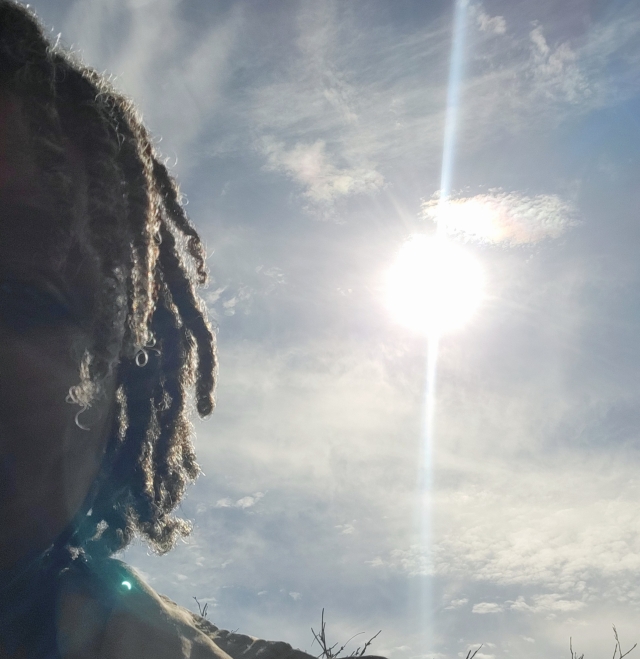Um … so then I realized that I only typed up four of my late triolets in yesterday’s post. Right. Clearly, I still need to catch up on my rest so I can trust my counting skills again! So tonight I’ll post today’s poem and yesterday’s, too.
Yesterday I wanted to write about limerence. I like the word but not what it is. I’m sure there’s something in its etymology that explains why this word is attached to something that seems entirely lousy. I’m sure this isn’t the only pretty word that means something decidedly unpretty. Whatever. So I thought about my own experiences with limerence, and came up with:
All caught up in limerence,
a story my heart insists on telling.
The story is layered thick and intense,
all caught up in limerence
like a fish in a net. It makes no sense
this wasted love, my heart swelling
all caught up in limerence,
a story my heart insists on telling.
Today, of course, was eclipse day. Did you watch? Were you on/near the path of totality? Were you sappily happy about it the way I was? I hope so. It was a good feeling. 🙂
I went with a friend (and hundreds of other folks) to the Brooklyn Botanic Garden to eclipse-watch. I was sartorially prepared:
In addition to my moon and stars tights, I had sun and moon earrings that I forgot to take a picture of. I had the equivalent of eclipse glasses for my phone, and — of course — glasses for me, too:
I bought these a few weeks ago to be sure I’d be ready … and I bought them specifically because I wanted to wear the orange ones, so I did. 🙂 They’re good glasses. Good enough that I’ll try to keep track of them until the next eclipse!
My friend was a great eclipse-watching partner. She was so awed by the coolness of seeing the moon assert herself across the sun. According to all the lead-up reporting, we were supposed to be at 90% of totality. I have to say that I think we were more than that. At peak coverage, there was only the sliver-iest sliver of sun left visible, which was excellent. I liked my glasses a lot, but the filter thing I bought for my phone was mostly annoying. It gave me a lot of funky images like the one below, but nothing like what I wanted.
And then I remembered that during my last solar eclipse (2017?) I had taken selfies that had captured the eclipse in a weird and fun way, so I decided to ditch the filter and try that again. Success!
(I kind of love the one that has the eclipse on my shoulder! )
And so, my triolet. Naturally, I had to write something connected to the eclipse. The day started with a friend posting in the group chat about Bonnie Tyler’s “Total Eclipse of the Heart.” (I mean … of course.) But it was Pink FLoyd that was in my head all day. (Also of course.) I wanted to be cute and do a “found triolet,” pulling lyrics from both songs to make my poem, but I couldn’t fit them together well enough. My repeated AB lines are one from Tyler and one from Floyd, though. It doesn’t work as well at all, but I’m determined to have my way, so you are stuck with the result. Maybe the title for this one should be “A 90% Eclipse of the Heart.”
Every now and then I fall apart
but the sun is eclipsed by the moon.
I manage to make a promising start
every now and then. I fall apart
when I forget my heart,
forget how much it longs to swoon.
Every now and then I fall apart
but the sun is eclipsed by the moon.
National Poetry Month 2024: the Triolet
For April, I choose a poetic form, and try to write a poem in that form every day. I’m not always successful, so we’ll see how this year turns out. I’ve chosen some longer forms in the past, which has made my life a bit difficult, but I’ve never gone crazy and chosen something like a sestina or villanelle.
The “Triolet” is the form I’ve chosen for this year. Here is the structure and a little backstory (thank you Britannica and the Poetry Foundation):
Triolet
A medieval French verse form with eight short lines rhyming ABaAabAB (the capital letters indicate lines that are repeated). The name triolet is taken from the three repetitions of the first line. The great art of the triolet consists in using the refrain line with naturalness and ease and in each repetition slightly altering its meaning, or at least its relation to the rest of the poem.
The requirements of this form are straightforward: the first line is repeated in the fourth and seventh lines; the second line is repeated in the final line; and only the first two end-words are used to complete the tight rhyme scheme. Thus, the poet writes only five original lines, giving the triolet a deceptively simple appearance.
What are you writing this month?
This image is the Academy of American Poets’ 2024 poster for NaPoMo. The line is from a Lucille Clifton poem (and if you’ve known me for more than a minute, you know how much I love and revere Ms. Clifton). You can request your own poster, too!








